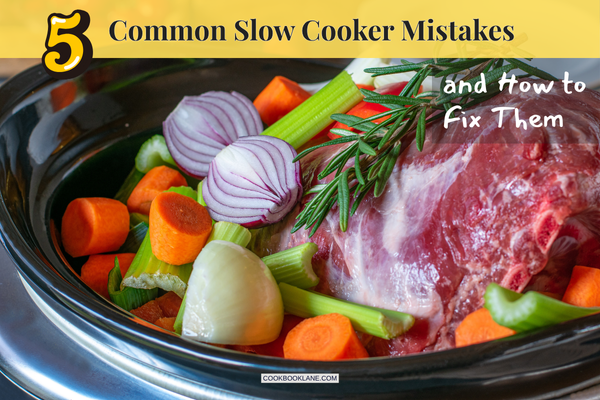
5 Common Slow Cooker Mistakes (and How to Fix Them)
If your slow cooker dinners sometimes turn out mushy, bland, or overcooked, you’re not alone. Many beginners make the same slow cooker mistakes—and the good news is, they’re easy to fix! With a few simple tweaks, you can create tender, flavorful meals that taste like they simmered all day (because they did!).
Let’s look at the five most common slow cooker pitfalls and how to avoid them so you can start cooking with confidence.
1. Overfilling the Slow Cooker
One of the biggest slow cooker mistakes is filling it to the brim. It’s tempting to pack everything in, but when the pot is too full, food won’t cook evenly. Liquids may bubble over, and your meal can become soggy or undercooked in spots.
Solution: Only fill your slow cooker two-thirds full. This allows enough space for heat to circulate and moisture to build properly. If you have more ingredients than will fit comfortably, cook in batches or use a larger crockpot.
2. Adding Too Much Liquid
Unlike stovetop cooking, very little liquid evaporates in a slow cooker. If you add the same amount of broth or water you’d use for a soup or stew, you might end up with a watery dish.
Solution: Cut back on liquid by about one-third when adapting recipes for your slow cooker. Remember—meat and vegetables release moisture as they cook, so less is more. If your dish still turns out thin, you can remove the lid for the last 30 minutes to let some liquid evaporate.
3. Lifting the Lid Too Often
It’s tempting to peek at your meal while it cooks, but every time you lift the lid, heat escapes. That simple mistake can add up to 30 extra minutes of cooking time and affect how evenly your food cooks.
Solution: Resist the urge! Trust your recipe’s timing. If you must check, do it near the end of the cooking cycle. Modern slow cookers maintain consistent heat, so you can relax and let it do the work for you.
4. Forgetting to Brown Meat First
While slow cookers are designed for convenience, skipping the browning step can lead to bland results. Searing meat before adding it to your crockpot develops rich flavor and better texture.
Solution: Spend just five minutes browning meat in a skillet before it goes into the slow cooker. That quick step adds depth and a delicious caramelized flavor. You’ll taste the difference in every bite.
5. Cooking Everything on High
Many new users assume that setting the slow cooker to “high” will make dinner faster and just as tasty—but that’s not always true. Some foods, especially tougher cuts of meat, need low and slow heat to break down properly.
Solution: Use the “low” setting for dishes like roasts, stews, or chicken thighs. The longer cook time allows flavors to blend beautifully. Save the “high” setting for quick soups or recipes under four hours.
Can You Overcook Meat in a Slow Cooker on Low?
It might surprise you, but yes—you can overcook meat in a slow cooker, even on the low setting. While slow cookers are designed to gently tenderize tougher cuts like chuck roast or pork shoulder, cooking them for too long can dry them out and cause the fibers to break down too much. Instead of juicy, pull-apart meat, you might end up with something stringy or mushy. Each type of meat has its own “sweet spot” for cooking time, so it’s worth keeping an eye on the clock, especially during your first few tries with a new recipe.
Always Follow the Recipe If Possible
For best results, follow the recipe’s recommended time and check for doneness near the lower end of that range. Chicken breasts, for example, are best cooked on low for about 4–6 hours, while a hearty beef roast might need 8–10. If you’re not home to turn it off, a slow cooker with a built-in timer or “keep warm” function is a smart investment—it helps prevent overcooking while keeping your meal ready when you are. With a little practice, you’ll learn the perfect timing for your favorite recipes and never have to worry about dry, overdone meat again.
Now that you know how to avoid overcooking, let’s talk about how to make your slow cooker experience even easier. The best way to build confidence in the kitchen is to start with simple recipes that always turn out great. Once you have a few dependable favorites, you can get creative and try new flavor combinations without stress.
Once you’ve mastered these slow cooker tips, try one of my reader favorites — 10 Slow Cooker Chicken Dinners You Can Freeze Ahead — or start small with a Slow Cooker Pot Pie Stew recipe.
Bonus Tip: Start Simple
If you’re new to slow cooking, start with easy, tried-and-true recipes. You’ll gain confidence and learn how your slow cooker behaves. Once you feel comfortable, you can experiment with your favorite flavors and ingredients.
For a great place to start, check out 35 Slow Cooker Chicken Recipes on Amazon Kindle—packed with beginner-friendly dishes that are delicious, comforting, and simple to make.
Final Thoughts
Slow cookers are one of the most forgiving kitchen tools you can own, and once you know how to avoid these slow cooker mistakes, you’ll love how effortless home cooking can be. Whether you’re cooking for one or feeding a family, your crockpot can make dinner stress-free and satisfying.
Looking for more beginner cooking tips and small-batch ideas? Visit Cooking for Two on Cookbook Lane for practical guides that make everyday cooking easy and enjoyable.
Want more recipes, kitchen inspiration, and cooking resources? Explore more of my cookbooks at my Amazon Author Central Page.
With the right tips and a little practice, you’ll soon be the slow cooker expert in your kitchen!


